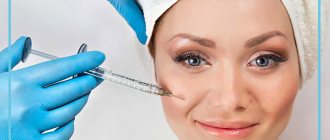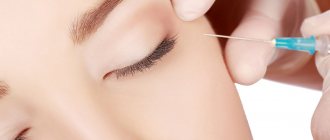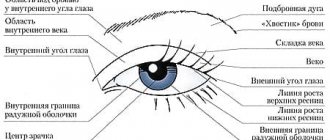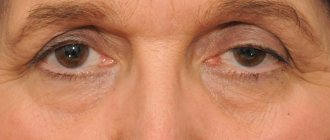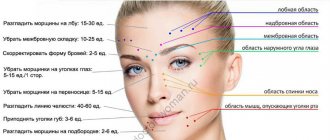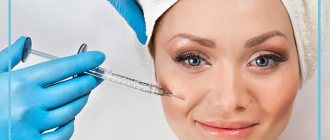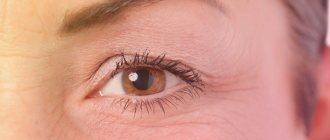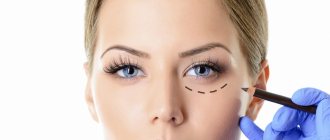Due to the property of botulinum toxin to eliminate muscle spasms, this drug is used both in medical practice and in cosmetology. The injections contain a natural purified toxin in small doses and help correct minor skin changes. The protein acts on muscle tissue, blocking the transmission of nerve impulses, as a result, facial wrinkles relax. But sometimes problems arise. Most often it happens that after Botox the eyelids droop, and the doctor should tell you what to do.
According to statistics, after a Botox procedure, 16-18% of patients experience ptosis, or drooping eyelid. No one is immune from this side effect, since in many cases it develops for reasons beyond the control of the cosmetologist. And then the first question will be, if after Botox your eyelids droop - what to do?
Symptoms
In order not to confuse ptosis after injections with other pathologies, you need to know about the symptoms. The eyelid may droop either on the third day or after a few weeks. This is very noticeable. Obvious asymmetry gives the face an unpleasant, tired expression and the gaze a heaviness. In this case, blinking is impaired, as a result the eyeball is almost deprived of hydration and cleansing, as well as:
- your eyes begin to hurt;
- blood circulation is impaired;
- headaches, strabismus and lacrimation appear.
By location, swelling is most often unilateral, but it can also be bilateral. Thus, a situation may arise when, for one reason or another, the eyelids droop after Botox. What to do? Photos and reviews of other patients, the opinions of doctors - all this is of interest, but the main thing is not to panic.
What are the consequences of ptosis of the upper eyelid?
Drooping of the eyelid as a result of an unsuccessful Botox injection is accompanied by unpleasant symptoms. Among them:
- Pronounced facial asymmetry, resulting from significantly different sizes of the palpebral fissures. In addition to the eyelid, sometimes one of the eyebrows droops, which makes the asymmetry even more noticeable.
- Problems with cleaning and moistening the eyeball, resulting from the inability to blink. In some cases, this causes chronic eye irritation.
- Difficulty trying to close the eyes completely, caused by loss of muscle control. Because of this, the visual organs are in constant tension, quickly get tired, and heaviness is felt in the frontal region. To look at objects, you have to tilt your head back, this provokes poor circulation and headaches.
- Problems with the drainage of tear fluid, causing tears to constantly flow from the eye.
If not only the lifting eyelid muscles are damaged, but also the oculomotor muscles, then, in addition to eyelid ptosis, strabismus and decreased visual acuity may occur.
All of these side effects are rare. However, even one of them is enough to worsen the quality of life and increase the level of discomfort.
Primary causes
Before carrying out a cosmetic procedure aimed at eliminating wrinkles in the eye area, the risks of side effects must be taken into account.
If your eyelids droop after Botox, this can happen for two reasons. Physiological, which are considered primary, are determined by the mechanisms of interaction of botulinum toxin with muscle fibers. One of them is complete or partial denervation of the muscle that raises the upper eyelid. In other words, its connections with the nervous system are interrupted and it is unable to contract. If this happens to only part of the muscle, then the remaining active one is not able to hold the eyelid completely, so it droops a little. If everything is denervated, then the eye closes completely.
The second reason is a decrease in the activity of the orbicularis oculi muscle and the one that drains lymph during contraction. As a result, tissue fluid and blood accumulate in them, swelling appears, which spreads to the eyelid. It becomes heavier and sinks.
Degrees of ptosis
Ptosis varies in the degree of impact on the patient’s life:
- First degree (partial ptosis) – the eyelid is drooping, but the volume of the palpebral fissure is reduced by no more than 1/3;
- Incomplete (2nd degree) – a drooping eyelid covers 2/3 of the iris, accompanied by significant visual impairment (double vision, lacrimation, narrowed vision);
- Complete (3rd degree) – the palpebral fissure is completely blocked, the drooping eyelid makes it impossible to see with the affected eye.
With Botox, partial ptosis most often develops, and incomplete ptosis is extremely rare. Complete ptosis develops in severe forms of allergy to the drug.
Secondary causes
The answer to the question of why eyelids droop after Botox torments everyone who has encountered this problem. Secondary reasons are due to the specifics of the procedure itself and rehabilitation after it. Although the principle of action of the drug is the same for all patients, in some the intervention proceeds well, while in others undesirable effects occur.
Drooping eyelids after botulinum toxin injections can result from:
- Individual reaction to the administered drug.
- Administration of the drug into the muscle that lifts the eyelid, when the distance to the orbicularis oculi muscle, into which the injection is made to get rid of the so-called crow's feet, is incorrectly calculated.
- Uneven distribution of the drug among injection points.
- Ignoring anatomical features such as an asymmetrical face and narrow forehead.
Also, too high a dosage can lead to this result. In this case, this is a consequence of inaccurate injections or improper dilution of the solution. Overdose often occurs among doctors who, following a new trend, inject botulinum toxin in large doses. Although 10 units of the drug are usually enough for a pronounced effect, they administer from 35 to 50. High dosages, in addition to making the rejuvenation procedure more expensive, also increase the risk of various kinds of complications. This approach is absolutely not justified, because if the effect of 10-15 units seems too small, the missing amount can always be added a little later.
If at the very beginning there are signs of ptosis on the face, then, first of all, it is necessary to cure it, and then carry out the procedure, because initially the muscle tone is not normal.
Experts' opinion
The advantage of Botox is that the procedure itself takes 10-15 minutes and does not affect the ability to work, which is why in Europe it is called the lunch break procedure. However, experts advise spending more time on the preliminary examination and subsequent recovery period to reduce the risk of undesirable consequences. Even if Botox is not done for the first time, such subtleties should not be neglected.
If ptosis occurs, you don’t have to do anything if it only causes aesthetic discomfort - muscle activity recovers on its own within six months. During this time, the patient will have to endure a number of inconveniences - spoiled appearance, facial asymmetry, unwanted attention from others, but over time this will end. Those for whom it is very important to maintain a beautiful appearance need to think about treating or camouflaging ptosis.
According to statistics, ptosis occurs in 16-18% of cases, so before the procedure you should weigh your preferences and possible risks - are the problems with your face so severe that they are worth solving at the cost of the risk of getting even bigger problems. Even with repeated Botox, the risk does not decrease, so experienced patients face the same dangers as those who decided to make such changes for the first time.
Watch the video on the topic:
How long should I wait for the natural return to rise?
Of course, in such a situation, women are interested in whether their eyelids droop after Botox, when the trouble will go away. Botulinum toxin is eliminated from the body gradually, as soon as its concentration begins to decrease, the asymmetry disappears, therefore one of the best medicines is time. The recovery process will end in two weeks, and may last for several months. It depends on the:
- degree of drooping eyelid - partial or complete;
- individual features of facial structure;
- muscle tone;
- accuracy in following the doctor’s prescriptions and recommendations.
Who is guilty
People pay large sums for procedures in clinics. At the same time, many doctors assure the safety of the procedure. Therefore, after side effects appear, patients begin to wonder who is to blame.
Quality rests on the shoulders of the doctor. But the consequences are not always associated with his actions. The occurrence of a side effect is associated with several factors:
- Intolerance to the toxin and elements included in the drug. This reason applies to cases of too frequent carrying out. The first injections rarely reveal intolerance. Too high a concentration of poisons accumulates if 10 procedures are performed, which are repeated for several years. A break is required for the cells to partially restore their abilities. During this period, toxic substances break down. However, many properties of the fabric are no longer returned.
- High dosage of the drug. It all depends on the place of administration of the drug, the desired result and some other factors. Incorrect dosage is not always a sign of insufficient qualifications of the doctor. Even with a lot of experience, cases are not like others.
- Inexperienced specialists often administer the toxin according to a universal scheme without taking into account the patient’s characteristics. Danger points are a zone 1 cm from the inner edge of the eyebrow. At the same time, the location of the eyebrow is different for everyone. If the doctor injects a substance into the muscle that supports the eyelid, it will droop.
- Correct distribution of injection across tissues. For all drugs, the degree of distribution of the active substance is different. If the doctor did not take this into account, the toxin can also reach the muscles of the eyelid.
All cases are associated with incorrect actions of the doctor. The clinic must create all conditions to reduce risks.
Ways to eliminate ptosis after Botox
After Botox injections, the eyelids drooped, those who have such a complication want to know what to do. The first thing you need to do is contact a cosmetologist. After the inspection, he will establish a sequence of actions to correct the problem. Ptosis is a reversible process, but the duration of therapy is difficult to determine. Doctors have several treatment methods at their disposal, the use of which can speed up the overall restoration of energy in paralyzed muscles and improve the appearance of the face.
Help with complications after botulinum therapy
Any complications that arise after injections require a professional, competent approach. Therefore, if you experience side effects, for example, a drooping forehead, facial asymmetry, or swelling of the eyes after Botox, contact experienced specialists.
Our clinic has a special department for dealing with complications from cosmetic procedures. Reception is carried out by qualified doctors with many years of experience in their field of specialization.
Our clinic’s specialists will diagnose and help correct almost any side effects of botulinum therapy - remove swelling and bumps after Botox, eliminate ptosis, asymmetry or other complications after cosmetic procedures.
Administration of another dose of botulinum toxin
If after Botox the upper eyelids droop, then the cosmetologist may decide to inject another dose of the drug into the fibers that lower the upper problematic eyelid. This method will help balance the strength of the muscles, after which the eye will open normally.
There is another option that can be used for mild ptosis. The cosmetologist finishes off the muscles that raise the eyebrow on the opposite side. After this procedure, it will lower slightly, the size of the eyes will become almost the same and the asymmetry will be barely noticeable.
Drug treatment
Modern methods of correcting the situation when eyelids droop after Botox include the use of medications that will help speed up the restoration of mobility of problem muscles and strengthen nearby fibers.
For these purposes the following are often prescribed:
- vitamin complex for oral administration “Neuromidin”;
- injections of "Proserin";
- Apraclonidine eye drops;
- mesotherapy cocktails with active substances that accelerate the restoration of muscle tone and mobility.
Course use of Apraclonidine allows you to raise the edge of the eyelid by approximately 1-2 mm. This is sufficient for mild to moderate ptosis, but for severe ptosis this method is only suitable as part of complex therapy.
Methods for correcting the position of eyelids and eyebrows
There are several ways to remove ptosis caused by neurotoxin injections. The most effective, natural and safe, but also the longest in terms of obtaining the expected effect, is stimulation of the muscle that lifts the eyelid through various physiotherapeutic procedures. With such stimulation, metabolic processes in the muscle are accelerated and its innervation is restored faster. In addition, with partial ptosis, those fibers that remain active are “trained” and more effectively lift and hold the eyelid, over time taking on part of the load from the inactivated part of the muscle. As a result, ptosis goes away faster during such procedures. Practice shows that with a targeted fight against it, it is possible to ensure that the normal position of the eyelid is restored in 3-4 months.
One of the effective physiotherapeutic methods of combating drooping eyelids is galvanization.
Such procedures are often carried out for cosmetic purposes, are well tolerated by patients and are often already familiar to them. In particular, for the treatment of ptosis the following are carried out:
- Muscle massage is the simplest procedure that after several sessions the patient can master and carry out independently. It helps to activate metabolic processes in the muscle and accelerate its reinnervation;
- Microcurrents that promote the regeneration of various structures in the skin, and in some cases in the muscles. With correctly selected current parameters, they accelerate the restoration of innervation of muscle fibers;
- Thermolifting, which provides some tightening of the skin, and with it a slight lifting of the eyelid. In some cases, this is enough to eliminate the defect;
- Installation of microthreads that give a result similar to thermolifting - tightening of the skin, and with it the eyelids.
Microcurrents and muscle massage can reduce the time required to eliminate ptosis to 3-4 months, thermolifting and microthread therapy – to 2-3 months. However, in most cases it is impossible to combine these procedures due to the risk of side effects.
It is important to remember that the cost of such procedures may be greater than the cost of botulinum therapy itself. Therefore, each patient determines the feasibility of carrying them out independently.
It is also possible to administer some stimulant medications. Of these, injections of Proserin, Neuromultivit or Neuromidin, mesotherapy with DMAE drugs, and Apraclonidine eye drops are most often used. They will not give a quick and powerful result, but in a few weeks they will allow you to raise the eyelid by 1-1.5 mm. In some cases this may be sufficient.
Some drugs can lift the eyelid up to 1.5 centimeters within a few weeks.
Finally, as an option for correcting drooping eyelids, the injection of botulinum toxin into the lower part of the orbicularis oculi muscle, which ensures its closure and lowering of the eyelid, is sometimes considered. Since there is no antagonist in the muscle that lifts the eyelid, this option is not very effective, but it can ensure that the eye opens a little wider than it normally does. Visually, this compensates for the effect of a drooping eyelid.
However, this method is hardly predictable. Firstly, normally the orbicularis oculi muscle does not pull the eyelid down and therefore does not cause ptosis when the upper muscle is relaxed. That is, its relaxation will not necessarily lead to a lifting of the eyelid: a lot here depends on the distribution of the toxin in the tissues after the first procedure. Secondly, if you accidentally inject a little more than the required amount of the drug into the pretarsal part, you can deactivate it completely, which is why the patient will not be able to close the eyelids at all.
For these reasons, Botox injections into the lower part of the eye to combat ptosis are rarely done.
Injections into the lower part of the eye to lift the eyelid do not guarantee the expected result, so they are usually not done.
On a note
In case of pathological blepharoptosis (that is, one that is caused by disorders in muscle function, and not by botulinum therapy), botulinum toxin is sometimes used, but this is done only when the doctor has accurately diagnosed the causes of the condition and is absolutely confident in the effectiveness of the procedure. Normally, an attempt to lift the eyelids using Botox is ineffective due to the specific structure of the orbicularis oculi muscle. But for raising eyebrows, botulinum toxin preparations are quite suitable - with correctly selected injection points, you can relax the muscles that lower the eyebrows, as a result of which the eyebrows will rise. Here, again, high precision and professionalism of a cosmetologist is required, who will be able to raise the eyebrows by a sufficient amount, but will not allow them to be excessively lifted and the “Mephistopheles eyebrows” effect.
Surgeries to eliminate ptosis after botulinum therapy are never performed.
Physiotherapeutic procedures
If your eyelids droop after Botox, then one of the treatment methods should be physiotherapeutic procedures. Their main task is to restore the lost vital activity of muscle fibers in the shortest possible time. The most effective include myostimulation and microcurrents. The procedures are quite expensive, but with their help it is possible to quickly get rid of swelling and cope with ptosis.
All types of massage bring good results, this also applies to kneading the problem area yourself with your fingers.
When will the position of the eyelids be completely restored?
Complete natural restoration of the position of the eyelids usually occurs after 7-8 months, however, these periods are determined by the individual characteristics of the body and the amount of the drug administered.
So, in some patients, Botox and its analogues stop working after 5-6 months, while in others this period extends to 13-15 months. However, these cases are rare, and the norm is considered to be exactly 7-8 months for normal doses of Dysport or small doses of Botox and its analogues, or 9-12 months for normal doses of Botox.
If ptosis is caused only by swelling and heaviness of the eyelid after injections, but did not arise due to the action of the drug on the muscle that lifts the eyelid, it will go away when the swelling goes away - within two to ten days. If, after the procedure, swelling does not develop at all, or has already arisen and gone away, but ptosis remains, it means that this complication is long-term and will go away on its own only when the effect of Botox injections is completed.
It is also useful to read: Botox from the Allergan company and its use in cosmetology
Traditional methods
If it so happens that your eyelids droop after Botox, you can try to treat it at home, resorting to special procedures, namely, making warm compresses and inhalations using medicinal herbs.
A positive result will be obtained by applying a boiled egg in the shell, a bag of heated cereal or salt to the forehead or between the eyebrows for 15-20 minutes. The procedure should be carried out every day. But it must be borne in mind that this thermal method can be used if there is no swelling.
You can do a little massage yourself at home. First, it is recommended to apply a cream that has a tightening effect to the area around the eyes and eyelids to create additional hydration and enhance the effect. Then you need to perform circular stroking, light pinching and patting in a clockwise direction. Thanks to massage movements, the drug begins to be removed from the cells faster.
Facial inhalations performed over herbal decoctions, such as:
- sage;
- calendula;
- chamomile.
For this procedure, one of the listed herbs should be brewed with boiling water, poured into a pan, over which you need to bend and inhale the aroma for 5-10 minutes.
Paraffin eyelid masks can help in this difficult situation. To do this, you need to melt the paraffin and add 2 drops of lavender oil. Dip napkins in the resulting mixture, apply to the eyes, do not touch the eyelashes. After the composition has hardened, remove.
Medical recommendations
To quickly return the face to natural symmetry and reduce the severity of swelling, a cosmetologist can offer one of the following procedures:
- Another injection of toxin. An experienced specialist can determine which points are causing the ptosis and find the area where injection of Botox will help achieve muscle lift.
- Carrying out therapeutic physiotherapeutic procedures. To restore muscle tone, you can take a course of microcurrents and myostimulation. Electrophoresis with medicinal components, galvanic currents, and massage are no less effective.
- Carrying out a surgical operation. Required in difficult cases, for example, when Botox is completely removed from the body and ptosis persists.
In some cases, medications help: eye drops, vitamin preparations for oral administration.
You can perform a massage at home, but you need to do the procedure strictly every day. The first session is possible 3-4 days after the administration of the toxin. The skin is massaged in a circular motion in the direction of the massage lines.
Why can our articles be trusted?
We make health information clear, accessible and relevant.
- All articles are checked by practicing doctors.
- We take scientific literature and the latest research as a basis.
- We publish detailed articles that answer all questions.
In any case, only a doctor can prescribe the correct treatment and determine an accurate diagnosis. Self-medication is not recommended, as it can not only slow down the recovery period, but also cause additional harm to health.
How to prolong the effect of treatment?
If the patient carefully follows all the recommendations and prescriptions of the cosmetologist regarding the treatment of drooping upper eyelids, then eventually this complication gradually disappears. To consolidate the result, it is advisable to listen to simple advice. One of them concerns the need to continue to massage to keep the muscles toned. Doctors recommend starting to do gymnastics specifically designed for the face - face building. It helps train muscle fibers. It is necessary to apply a firming eye cream every morning and evening. A mask using gelatin can help a lot. You should mix 1 tbsp. l. gelatin and milk. After it dissolves, add a capsule of vitamin A and E and apply the mixture to your eyelids. Once it dries, wash using warm water.
About Botox
After the first use of the substance to correct appearance, it became in demand. This is due to visible changes after the first procedures. All drugs use a toxin. Manufacturers add other components to reduce negative effects.
There are many companies involved in the production of drugs. The difference is in composition, effectiveness, achieved effect and danger. In addition, they differ in price.
The effect of the drug is associated with blocking nerve impulses. They do not give commands to contract muscle tissue. Due to the immobilization of the muscles, the skin becomes smoother. However, the procedure cannot be called rejuvenation. It gives only a temporary effect and reduces the ability of cells to recover. The body gets used to the poison and it becomes less effective.
What to do to prevent drooping eyelids?
No one is immune from such a situation, when eyelids droop after Botox on the forehead. However, this can be minimized. First of all, experts advise that when carrying out rejuvenation procedures using injections, you should contact only cosmetologists who have extensive experience working with botulinum toxin and an excellent reputation. You should collect detailed information about the cosmetologist you are going to see for the procedure. An experienced doctor who has a huge amount of knowledge will not administer an excessive dose of the drug and will not make technical errors. And if any annoying consequences do occur, he will be able to eliminate them in the safest and most effective way.
The client should know that the procedure should be postponed if there are minor neurological symptoms in the form of a discolored or aged face, in other words, a significant decrease in tone due to fatigue, slight asymmetry after a busy day. Otherwise, overstrained muscle fibers will react to the injections completely unpredictably.
It is imperative to follow all recommendations, some of which are aimed specifically at preventing prolapse. For the first 24 hours after injections, it is forbidden to massage or rub your face. This is necessary so that the drug does not begin to spread beyond the treated muscle fibers; you should also not visit the sauna, bathhouse, play sports or do anything that will lead to an increase in body temperature. If this is not heeded, the swelling will intensify, resulting in temporary ptosis of the eyelid.
If the eyelid droops after Botox, the reviews, as expected, will be negative. Ptosis is an unpleasant phenomenon; it spoils the overall impression of the injection, even if wrinkles are smoothed out and the face becomes much younger. You should not wait until this complication goes away on its own; you need to take advantage of all the advice that the cosmetologist will give.
Comments for the site
Cackl e
Mechanism of occurrence
The active ingredient in Botox is a toxin that causes muscle paralysis. When administered correctly, it has an effect in those areas where wrinkles appear - it relaxes facial muscles, smoothes the skin, and helps make the face look younger.
If Botox is administered incorrectly, its effect affects places where it was not intended. Eyelid ptosis is caused by Botox injected into the corners of the eyes to correct crow's feet. The Botox injection procedure requires a very precise calculation of the injection point, so doctor errors are possible.
Who is to blame for the complication?
It is difficult to answer this question unequivocally. Exactly where Botox works depends on several factors:
- Correct calculation of the drug administration point;
- Accuracy of the procedure;
- Distribution of the substance under the skin after the procedure.
The first two factors are influenced by the skill of the doctor - only a good specialist can correctly calculate the area of injection of the medicine and place the injection exactly at the right point. On the other hand, after the procedure, the medicine is distributed under the skin for some time (this can take up to a day).
During this time, the patient must observe a number of restrictions - you cannot touch your face, fall asleep face down, you need to control your facial expressions, protect your skin from sudden temperature changes, and do not wear makeup. If this is not done, the drug will not end up where the doctor administered it.
The most common mistake patients make is coming to an eyelid Botox procedure without sunglasses. Prolonged squinting from bright light can negate all the doctor’s efforts.

